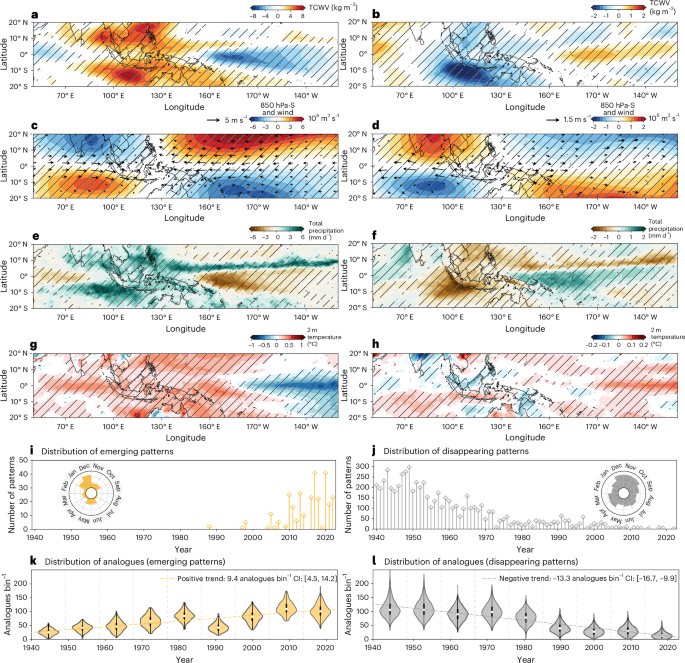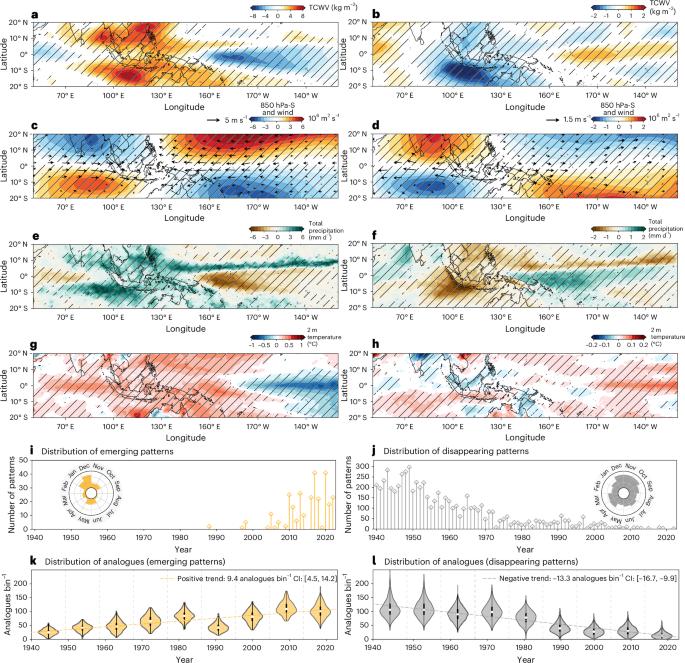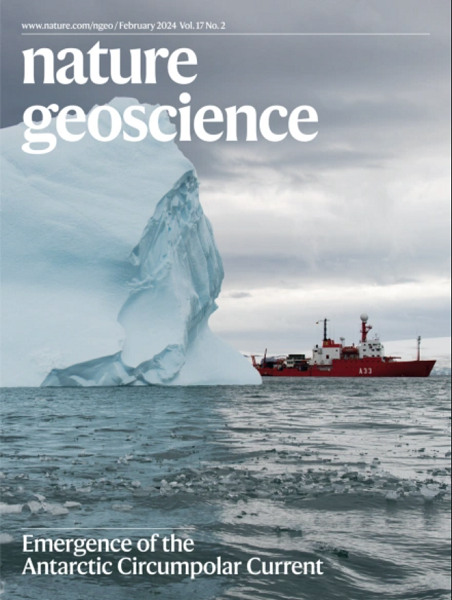热带天气模式的变化加剧了印度洋-太平洋地区的极端天气现象
IF 15.7
1区 地球科学
Q1 GEOSCIENCES, MULTIDISCIPLINARY
引用次数: 0
摘要
太平洋沃克环流和密切相关的厄尔尼诺/南方涛动影响着热带印度洋-太平洋地区的气候和天气。它们对该地区极端天气的出现,如热浪、强降水和长期干旱等,具有很强的控制作用,而这些极端天气正变得越来越频繁和严重。然而,气候模式很难准确模拟热带地区的大尺度环流变化及其对区域天气和未来气候的影响。在此,我们利用 1940 年至 2022 年的高分辨率ERA5 再分析数据研究了热带印度洋-太平洋地区天气模式的发生趋势。我们发现,印度洋-太平洋地区出现了 20 世纪 90 年代以前很少出现的新的大尺度天气形势,而其他一些突出的天气形势则消失了。这些新的天气形势与该地区异常比例的热浪和极端降水有关。这些天气模式在物理上与太平洋漫步者环流增强的趋势、东南亚更湿润和更温暖的条件以及赤道太平洋更干燥的条件相一致。这些变化不能完全用厄尔尼诺/南方涛动和其他相关的年际变化模式来解释,全球变暖、气溶胶强迫、外部强迫机制和非线性模式相互作用等其他因素也可能起作用。本文章由计算机程序翻译,如有差异,请以英文原文为准。


Indo-Pacific regional extremes aggravated by changes in tropical weather patterns
The Pacific Walker circulation and the closely connected El Niño/Southern Oscillation influence the climate and weather of the tropical Indo-Pacific region. They specifically exert a strong control on the regional occurrence of weather extremes, such as heatwaves, heavy precipitation and prolonged dry spells, which are becoming increasingly frequent and severe. However, climate models struggle to accurately simulate large-scale circulation changes in the tropics and thus their consequences for regional weather and future climate. Here we use high-resolution ERA5 reanalysis data from 1940 to 2022 to study the occurrence trends of weather patterns in the tropical Indo-Pacific region. We find that new large-scale synoptic situations that were rarely present before the 1990s have emerged in the Indo-Pacific, while some others that were prominent have disappeared. Those new synoptic situations are associated with an unusual proportion of heatwaves and extreme precipitation in the region. These weather patterns are physically consistent with a trend towards a stronger Pacific Walker circulation, wetter and warmer conditions in Southeast Asia and drier conditions in the equatorial Pacific. These changes cannot be fully explained by El Niño/Southern Oscillation and other relevant modes of interannual variability, and other factors such as global warming, aerosol forcing, external forcing mechanisms and nonlinear mode interactions may be contributing. Emerging weather patterns over recent decades are exacerbating extreme precipitation and heatwaves in the tropical Indo-Pacific region, according to a computation of trends in reanalysis data.
求助全文
通过发布文献求助,成功后即可免费获取论文全文。
去求助
来源期刊

Nature Geoscience
地学-地球科学综合
CiteScore
26.70
自引率
1.60%
发文量
187
审稿时长
3.3 months
期刊介绍:
Nature Geoscience is a monthly interdisciplinary journal that gathers top-tier research spanning Earth Sciences and related fields.
The journal covers all geoscience disciplines, including fieldwork, modeling, and theoretical studies.
Topics include atmospheric science, biogeochemistry, climate science, geobiology, geochemistry, geoinformatics, remote sensing, geology, geomagnetism, paleomagnetism, geomorphology, geophysics, glaciology, hydrology, limnology, mineralogy, oceanography, paleontology, paleoclimatology, paleoceanography, petrology, planetary science, seismology, space physics, tectonics, and volcanology.
Nature Geoscience upholds its commitment to publishing significant, high-quality Earth Sciences research through fair, rapid, and rigorous peer review, overseen by a team of full-time professional editors.
 求助内容:
求助内容: 应助结果提醒方式:
应助结果提醒方式:


